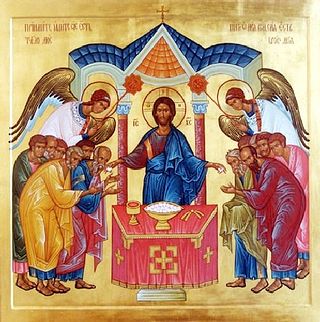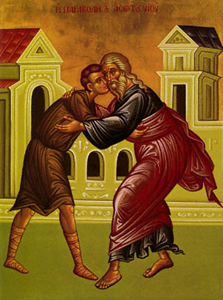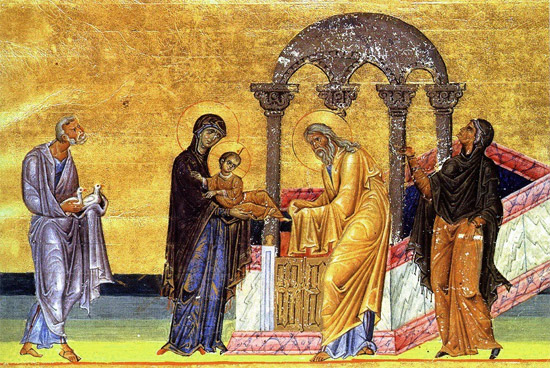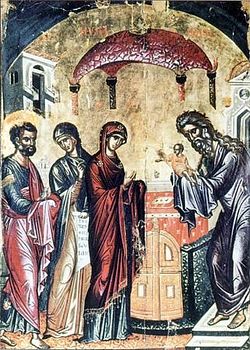Theology
What Should Be in Every Communicant of the Holy Mysteries Who Received the Lord in Them; and Who Does Not Have the Lord Within
5. March 2012 - 11:08 Homily on the first week of Great Lent
Homily on the first week of Great Lent
Our Lord Jesus Christ said, He that eateth my flesh, and drinketh my blood, dwelleth in me, and I in him (Jn. 6:56). Rejoice, O reverent communicants! True are the Lord’s words, and so undoubtedly is the Lord within you after you receive His Holy, Pure, and Life-Creating Mysteries. But brothers, the Lord who came to dwell in us cannot remain without witness in this inward activity, just as He cannot remain without witness in His outward Providence—He … gave us rain from heaven, and fruitful seasons, filling our hearts with food and gladness (Acts 14:17). He Himself said, If any man hear my voice, and open the door, I will come in to him, and will sup with him, and he with me (Rev. 3:20). So—do you meet with the Lord, and the Lord with you? I pose this question to you because there is perhaps no one here among you who has not already taken Communion of Christ’s Mysteries. Well then, has what should be the obvious fruit of this most glorious Mystery begun in you?
Homily On Wednesday Of The First Week Of Great Lent. On The Danger Of Hypocrisy
2. March 2012 - 12:27 Moreover when ye fast, be not, as the hypocrites.
Moreover when ye fast, be not, as the hypocrites.
Mt. 6:16
Beloved brethren! Our Lord Jesus Christ, Who commanded us to forgive our neighbors all their sins before we enter the podvig of fasting, also asked us to vigilantly preserve the fast itself free from hypocrisy. As a worm born within a fruit consumes what is inside, leaving only the outer covering, so does hypocrisy annihilate the whole essence of virtue. Hypocrisy is born of vainglory (cf. Mt. 6:1, 2, 5, 16). Vainglory is the vain desire and search for temporary human praise. Vainglory comes from a deep ignorance of God, or a deep forgetfulness of God, of eternity and heavenly glory. That is why in its blindness it insatiably strives to acquire earthly, temporary glory. It imagines this glory, as it also imagines earthly life, to be an eternal, inalienable possession. Vainglory, which seeks not the virtue itself but only praise for the virtue, labors diligently only that it might exhibit a mask of virtue before human eyes. Thus the hypocrite stands before humanity dressed in an outer garment of extreme deception: virtue—the essence of which he does not have at all—is seen on his exterior, while in his soul can be seen self-satisfaction and pomposity, because he first of all deceived and deluded in himself. He takes a sick delight in the vainglory that is killing him and in the misleading of his neighbor, and sickly and detrimentally delights in his successful hypocrisy. Along with all of this, he makes himself alien to God, for every one that is proud in heart is an abomination to the Lord (Prov. 16:5).
The First Week of Lent
29. February 2012 - 13:45This fast is referred to as Great due to both its significance and duration. It is made up of the Quadragesima (forty days) and Passion Week. The Quadragesima was established by the Church in order to observe the forty day fasting and prayer which our Lord kept after His baptism when He was in the desert – before He began His ministry of preaching the gospel. After the holy Quadragesima, which ends on the Friday of the sixth week of Lent, comes the fast of Passion Week, dedicated to our participation in the sufferings and death of our Lord Jesus Christ, according to His command that “the days will come when the bridegroom is taken away from them, and then they will fast...." (Luke 5:35).
Beginning of Great Lent 2012. Archpastoral Message of His Beatitude, Metropolitan Jonah
29. February 2012 - 9:52 To the Very Reverend and Reverend Clergy, the Venerable Monastics, and the Christ-loving Faithful of the Orthodox Church in America.
To the Very Reverend and Reverend Clergy, the Venerable Monastics, and the Christ-loving Faithful of the Orthodox Church in America.
Beloved in Christ:
“Enter again into Paradise!” So the Holy Church sings in the kontakion at Lent’s mid-point. At a time of year that coincides with college students’ “spring break” – an occasion for riotous and prodigal indulgence in the pigpen of the passions – the Church offers us a very different image of paradise. Fasting, vigil, silence and prayer, denial of self and generosity to others: these are the labors by which we are invited and commanded to regain our true, paradisal home.
In the three weeks that have led us to this great and solemn first day of the Fast, the Church has set before our spiritual eyes themes of exile. When our ancestors in the faith were led to captivity in Babylon, they wept; they hung up their lyres and said, “How shall we sing the Lord’s song in a foreign land? If I forget you, O Jerusalem, let my right hand wither” (Psalm 136:4–5). The Prodigal Son, at the eleventh hour, was given the grace not to forget his father’s house, and so he set his feet on the path of return. Our father Adam and our mother Eve chose exile and hardship for themselves and all their descendants through their disobedience, and yet they – and we with them – are shown the way home: we see the doors of repentance thrown open, and our loving Father in heaven keeping watch for our return with open arms.
What is the Spiritual Significance of the Feast of the Meeting of the Lord?
17. February 2012 - 9:57The events which gave rise to one of the twelve major feasts of the Lord, the feast of the Meeting, is, in the spiritual sense, multidimensional. The word “meeting”  does not convey the full meaning of the Church Slavonic word, sretenie. Those who meet are usually equals. “But here,” as Metropolitan Benjamin (Fedchenkov) notes, “the Slavonic word, sretenie, is more appropriate, because it speaks of the lesser going out to meet the greater; people, meeting God”[1] The events in the Jerusalem temple are of particular significance. The Divine Law-Giver Himself, as one Who is the image of the invisible God, the firstborn of every creature (Col. 1:15), and as the first-born of a Virgin (Mt. 1:25) is brought as a gift to God. This symbolic act is as a beginning of the service which will end on earth by a great event: The incarnate Son of God brings Himself entirely to the Father unto the redemption of mankind—who He met earlier in the person of holy righteous Simeon. For mine eyes have seen thy salvation, which thou hast prepared before the face of all people; a light to lighten the Gentiles, and the glory of thy people Israel (Lk. 2:30–32). By its thought and expression, this song of thanksgiving originates from portions of the book of the Prophet Isaiah: And in that day there shall be a root of Jesse, and he that shall arise to rule over the Gentiles; in him shall the Gentiles trust, and his rest shall be glorious (Is. 11:10). Jesse was the father of King David. Therefore, the root of Jesse, the Messiah-Christ whom people awaited, the Son of David (cf. Mt. 1:1), Who, as two thousand years of history has shown, would become a sign of contention. This sign divides people into the believing and the unbelieving, those who love the light, and those who love darkness. “What is this sign of contention? It is the sign of the cross, which the Church confesses as being salvific for the whole world” (St. John Chrysostom). The meeting of God and man, which first took place in the Jerusalem Temple, must become a personal event for every individual. The path of salvation must begin for each person by a meeting with Jesus Christ as his personal Savior. Until this meeting takes place, one remains sitting in darkness … and the shadow of death (cf. Mt. 4:16).
does not convey the full meaning of the Church Slavonic word, sretenie. Those who meet are usually equals. “But here,” as Metropolitan Benjamin (Fedchenkov) notes, “the Slavonic word, sretenie, is more appropriate, because it speaks of the lesser going out to meet the greater; people, meeting God”[1] The events in the Jerusalem temple are of particular significance. The Divine Law-Giver Himself, as one Who is the image of the invisible God, the firstborn of every creature (Col. 1:15), and as the first-born of a Virgin (Mt. 1:25) is brought as a gift to God. This symbolic act is as a beginning of the service which will end on earth by a great event: The incarnate Son of God brings Himself entirely to the Father unto the redemption of mankind—who He met earlier in the person of holy righteous Simeon. For mine eyes have seen thy salvation, which thou hast prepared before the face of all people; a light to lighten the Gentiles, and the glory of thy people Israel (Lk. 2:30–32). By its thought and expression, this song of thanksgiving originates from portions of the book of the Prophet Isaiah: And in that day there shall be a root of Jesse, and he that shall arise to rule over the Gentiles; in him shall the Gentiles trust, and his rest shall be glorious (Is. 11:10). Jesse was the father of King David. Therefore, the root of Jesse, the Messiah-Christ whom people awaited, the Son of David (cf. Mt. 1:1), Who, as two thousand years of history has shown, would become a sign of contention. This sign divides people into the believing and the unbelieving, those who love the light, and those who love darkness. “What is this sign of contention? It is the sign of the cross, which the Church confesses as being salvific for the whole world” (St. John Chrysostom). The meeting of God and man, which first took place in the Jerusalem Temple, must become a personal event for every individual. The path of salvation must begin for each person by a meeting with Jesus Christ as his personal Savior. Until this meeting takes place, one remains sitting in darkness … and the shadow of death (cf. Mt. 4:16).
The Meeting of the Lord
16. February 2012 - 9:55 According to the Law of Moses, all Hebrew parents must bring their first born son on the fortieth day after birth to the Temple to be consecrated to God. It was the custom to bring a sacrifice in thanksgiving to God. The law was established in remembrance of the exodus of the Hebrews from Egypt — freedom from slavery — when the first-born Hebrews were spared from death.
According to the Law of Moses, all Hebrew parents must bring their first born son on the fortieth day after birth to the Temple to be consecrated to God. It was the custom to bring a sacrifice in thanksgiving to God. The law was established in remembrance of the exodus of the Hebrews from Egypt — freedom from slavery — when the first-born Hebrews were spared from death.
In fulfilment of this law, the Mother of God with Joseph brought the infant Jesus to the Temple in Jerusalem and brought for the sacrifice two fledgling doves.
At this time in Jerusalem, there lived an old man by the name of Simeon. He was a righteous, pious man, and he awaited the coming of the Messiah. It was foretold to him by the Holy Spirit that he would not have died before he had seen Christ the Lord. Simeon waited for the fulfilment of the promise of God for a long time. According to tradition, he lived about 300 years. Then, one day, by the inspiration of the Holy Spirit, he went to the Temple. When Mary with Joseph brought the infant Jesus, Simeon met the Child, took Him in his arms, and glorifying God said, "Now lettest Thou Thy servant depart in peace, O Master, according to Thy word, for mine eyes have seen Thy salvation, which Thou hast prepared before the face of all peoples, a light of revelation for the Gentiles, and the glory of Thy people Israel."

